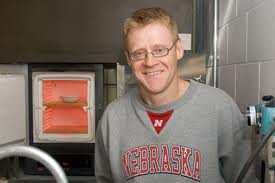
UNL chemistry professor Jody Redepenning will be featured in the Nebraska Center for Materials and Nanoscience's next Nanoscience Café. The discussion is 7 p.m. Nov. 15 at The Mill-Downtown, 800 P St.
Redepenning will talk about discoveries in composite biomaterials leading to hard tissue replacement for injured soldiers and others. The talk is free and suitable for a general audience.
For years, scientists have tried to create a composite that can replace bone. Redepenning has done just that. Through a simple process, Redepenning discovered a monomer that, when heated, becomes as hard as bone. That finding has led to the development of a biocomposite that can be used as bone replacement, a screw, other orthopedic appliances or hard-tissue replacements. The biocomposite creations can help soldiers returning from the battlefield or aging baby boomers.
Research at a nano level is occurring in many areas including physics, chemistry, material sciences, engineering, biology and medicine. Nanoscientists study and make new applications that improve computers, medical treatments, energy efficiency and more. The Nebraska Center for Materials and Nanoscience is on the forefront of research in one of the highest-priority national programs, the National Nanotechnology Initiative. Founded in 1988, the center supports more than 85 research scientists from the departments of physics, chemistry, electrical engineering, mechanical engineering, engineering mechanics, chemical engineering and others. The center also works with state and national industries in support of Nebraska's overall economic development.
Nebraska's Science Cafes share science research from university faculty with the public. Part of a grassroots movement, the objective is to engage the public in conversations about science with a casual, open format, using plain language, inclusive conversation and a welcoming and comfortable atmosphere for people with little or no science background -- or for those with science expertise looking to discover more about new topics.
— Terese Janovec, Nebraska Center for Materials and Nanoscience